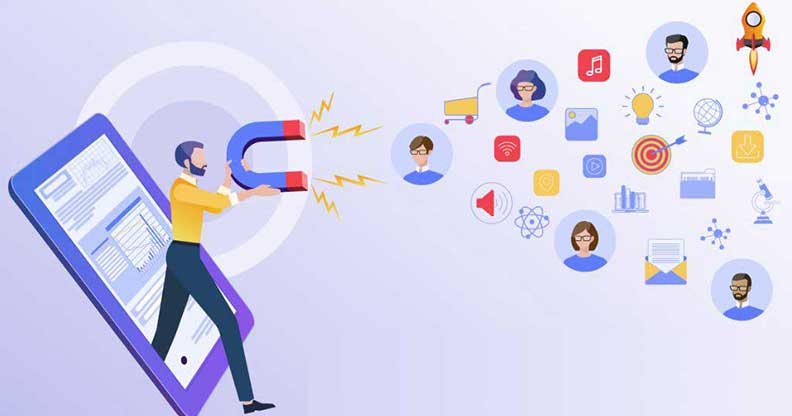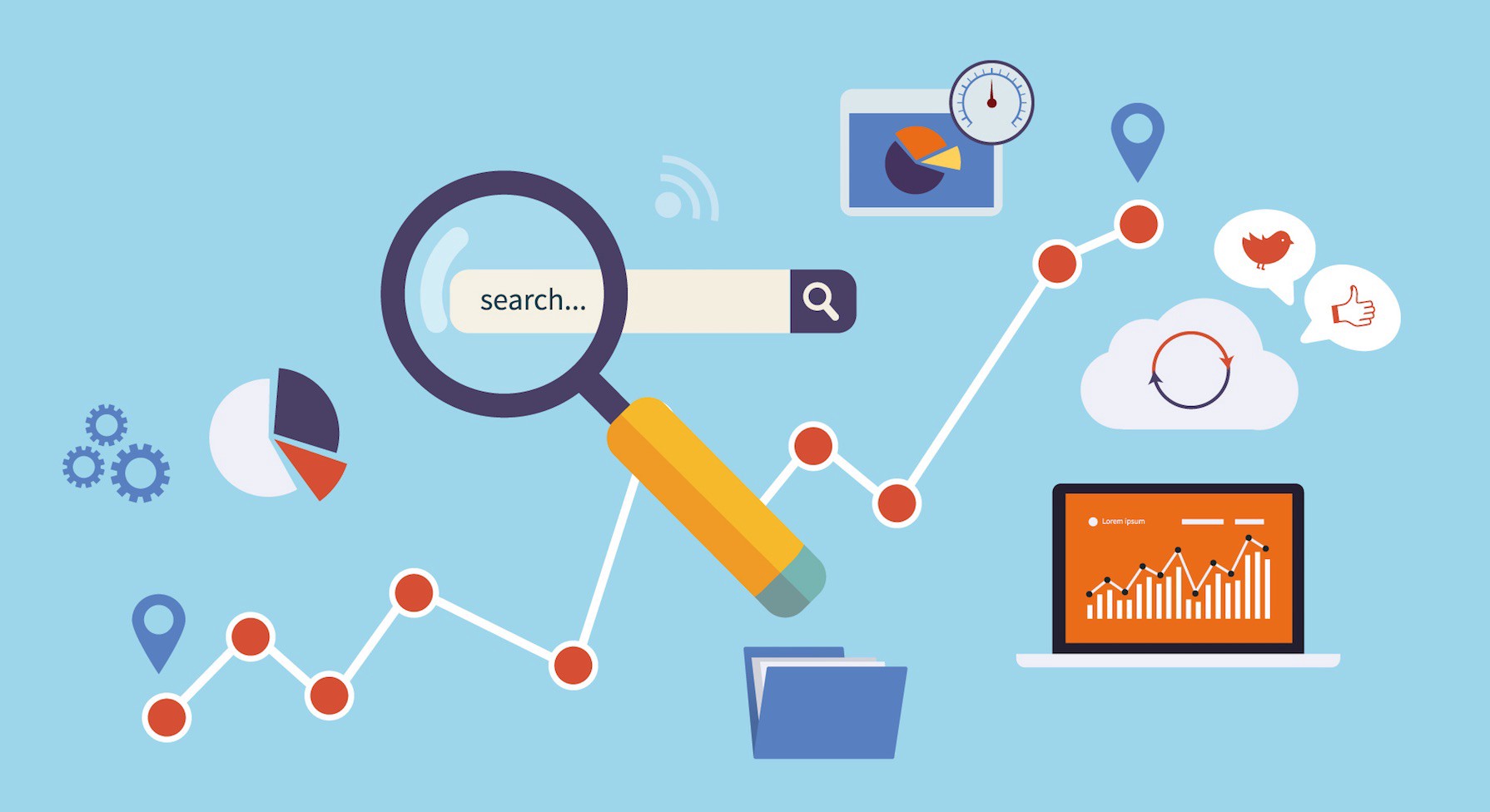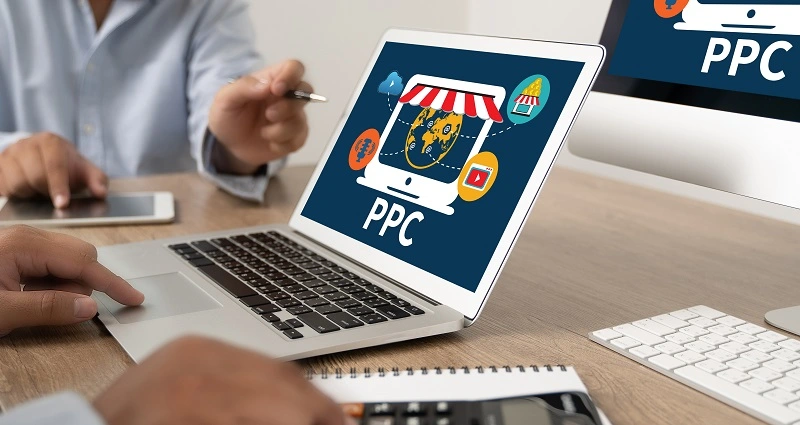
The Art and Science of B2B Lead Generation: Your Roadmap to Growth
September 18, 2025
Navigating the Digital Frontier: Data Privacy and AI Marketing Ethics
September 18, 2025In the competitive B2B (business-to-business) marketing world, success hinges on generating high-quality leads. Without a steady stream of potential customers, your business can struggle to thrive. This comprehensive guide will explore the art and science of B2B lead generation strategies. From understanding your target audience to implementing effective tactics, we’ll delve deep into B2B lead generation. Let’s cultivate success together!

Understanding Your B2B Audience
Defining Your Ideal Customer Profile
Defining your Ideal Customer Profile (ICP) is the foundational step in any B2B lead generation strategy. This profile represents the companies or individuals most likely to become your valuable customers. By crafting a detailed ICP, you create a roadmap for your marketing efforts, ensuring you’re targeting the right audience.
To create your ICP, consider factors such as industry, company size, location, job titles, and challenges your potential customers to face. This information helps you create highly targeted campaigns that resonate with your audience’s needs. For instance, if you offer a software solution for small businesses, your ICP might include companies with fewer than 50 employees operating in the tech industry, with titles like “CTO” or “IT Manager.”
Having a clearly defined ICP allows you to allocate your resources more effectively. You will only spend time and money trying to reach audiences likely to convert. Instead, your efforts will be concentrated on those prospects who are genuinely interested in what you offer.
Segmentation: The Key to Precision
Segmentation takes your understanding of the audience a step further. It involves dividing your audience into distinct groups based on shared characteristics or behaviours. This allows you to tailor your marketing messages for each segment, increasing the relevance and impact of your campaigns.
Consider a B2B SaaS company that provides project management software. They might segment their audience into categories like “Startups,” “Enterprise,” and “Mid-sized Companies.” Each of these segments has unique needs and pain points. Startups might seek cost-effective solutions, while enterprises require scalability and integration capabilities. The company can connect more deeply with its audience by creating content and messaging that speaks directly to these segments.
Segmentation is not a one-time task; it’s an ongoing process. As your audience evolves, so should your segments. Regularly review and update your segmentation to ensure your campaigns remain effective.
Psychographics: Reading Minds for Leads
Beyond demographics and behaviour, psychographics delve into the psychological aspects of your audience. What are their values, interests, aspirations, and pain points? Understanding these nuances allows you to create content that deeply resonates with your prospects.
Imagine a marketing agency specializing in B2B services. By understanding the psychographics of their audience, they might discover that their potential clients value innovation and staying ahead of industry trends. With this insight, the agency can create content that speaks to these aspirations, positioning itself as a thought leader and attracting like-minded businesses.
Psychographics can also help in crafting emotional connections with your audience. When you speak to their deeper motivations and desires, you’re more likely to capture their attention and foster a sense of loyalty.
Competitor Analysis: Learning from the Best
Competitor analysis is a valuable strategy for identifying potential leads. It involves studying your competitors’ customer base and understanding their target audience. While you don’t want to copy your competitors, you can learn from their successes and adapt your approach accordingly.
Consider a B2B software company operating in the same space as several competitors. They may discover untapped segments or unaddressed pain points by analyzing their competitors’ marketing efforts. It’s not about mimicking the competition but identifying gaps in the market that your product or service can fill.
Competitor analysis is an ongoing process. As the competitive landscape shifts, so should your analysis. Staying informed about your competitors’ strategies can help you stay one step ahead for valuable leads.

Crafting Compelling Content for B2B Audiences
The Power of Educational Blog Posts
Blogging is a cornerstone of B2B content marketing for good reason. Educational blog posts provide a platform to showcase your industry expertise and offer valuable insights to your audience.
Educational blogs are not about directly promoting your product or service. Instead, they focus on addressing pain points, providing solutions, and sharing industry knowledge. When your target audience finds your blog posts helpful and informative, they see your brand as a valuable resource.
For example, if you’re a B2B marketing agency, your blog might feature articles like “Effective Lead Nurturing Strategies” or “Maximizing ROI in B2B Advertising.” These topics provide actionable advice and establish your agency as a go-to source for B2B marketing knowledge.
When crafting educational blog posts, ensure they are well-researched, easy to read, and offer actionable takeaways. Consistency in publishing is critical to building trust and a loyal readership.
Ebooks and Whitepapers: Gateways to Leads
Ebooks and whitepapers are potent tools for lead generation in the B2B space. These in-depth, gated resources offer your audience a deeper dive into topics of interest. In exchange for this valuable content, prospects willingly provide their contact information, becoming leads in your database.
Let’s say you’re a B2B software company specializing in cybersecurity solutions. You could create an ebook titled “The Comprehensive Guide to Cybersecurity Best Practices for Enterprises.” This resource offers in-depth insights, actionable tips, and case studies that resonate with your target audience.
To maximize the effectiveness of your ebooks and whitepapers, promote them across multiple channels, including your website, social media, and email campaigns. Also, consider periodic updates to keep the content relevant and valuable.
Webinars and Podcasts: Engaging the Audience
Webinars and podcasts are excellent tools for engaging B2B audiences in real time. These interactive formats allow you to showcase your expertise, answer questions, and build relationships with your prospects.
Let’s take the example of a B2B marketing automation software provider. They could host a webinar on “Unlocking the Power of Marketing Automation for Lead Generation.” During the webinar, they can demonstrate the features of their software, share success stories, and engage with the audience through live Q&A sessions.
On the other hand, podcasts offer a more flexible approach to content delivery. They can cover a wide range of topics related to your industry, providing valuable insights to your audience on the go. Podcasts also offer opportunities for guest interviews and collaboration with industry influencers, further expanding your reach.
Both webinars and podcasts help position your brand as an authority in your field and offer a unique platform for direct interaction with potential leads.
Video Marketing: Show, Don’t Just Tell
Video marketing has become increasingly important in B2B lead generation. Videos have the power to convey complex ideas in an engaging and easily digestible format.
Consider a B2B software company specializing in data analytics. They could create short video tutorials demonstrating how their software helps businesses make data-driven decisions. Visualizing the software in action helps potential leads understand its value and functionality more effectively than a written description.
Video content can also include:
- Customer testimonials.
- Behind-the-scenes glimpses of your company culture.
- Explainer videos that simplify complex concepts.
Platforms like YouTube, Vimeo, and social media channels are ideal for sharing your video content and attracting potential leads.
Remember to keep your videos concise, informative, and visually appealing. Capturing your audience’s attention in the first few seconds is crucial in the age of short attention spans.

Leveraging Social Media for B2B Lead Generation
LinkedIn: The B2B Powerhouse
LinkedIn is the undisputed king of B2B social media platforms. It’s a goldmine for B2B lead generation, connecting professionals and decision-makers from various industries.
To leverage LinkedIn effectively, optimize your company page with compelling visuals, detailed descriptions of your products or services, and regular updates. Share thought leadership content, industry insights, and case studies to establish your brand as an authority in your field.
Participate in relevant industry groups and discussions to directly engage with potential leads. Building connections and nurturing relationships on LinkedIn is critical to generating high-quality B2B leads.
LinkedIn also offers powerful advertising options for targeting specific job titles, industries, and company sizes. Sponsored content, sponsored InMail, and display ads can help you reach decision-makers effectively.
Twitter: Real-Time Engagement
Twitter is a real-time platform where industry trends and discussions unfold rapidly. While it may not be as directly targeted as LinkedIn, Twitter can still be a valuable tool for B2B lead generation.
To maximize Twitter, actively participate in industry-related conversations using relevant hashtags. Share bite-sized insights, tips, and news updates that showcase your expertise. Encourage engagement by asking questions and running polls.
While Twitter might generate fewer leads than other platforms, it can be valuable to your B2B lead generation strategy, especially for brand visibility and engagement.
Facebook and Instagram: Not Just for B2C
While Facebook and Instagram are often associated with B2C marketing, they can also play a role in B2B lead generation. These platforms are not just for consumer-facing brands; they can effectively showcase your company culture, share success stories, and run targeted ads to reach your B2B audience.
Create a Facebook Page and Instagram Business Profile that reflect your brand’s personality and values. Share visual content that highlights your products or services in action. Case studies, client testimonials, and behind-the-scenes glimpses of your team can humanize your brand and attract potential B2B leads.
Facebook and Instagram also offer robust ad targeting options. You can tailor your ads to reach specific industries, job titles, and company sizes. Use these platforms strategically to promote gated content, webinars, or other lead-generation assets.
Creating Shareable Content
Creating content your audience wants to share is a valuable strategy for expanding your reach and attracting potential B2B leads. Shareable content can go viral within your industry, bringing your brand to the attention of decision-makers and influencers.
Consider creating infographics that present industry statistics or trends in a visually appealing way. Visual content is highly shareable and can position your brand as a source of valuable insights.
Crafting thought-provoking articles or blog posts that address industry challenges or offer innovative solutions can encourage your audience to share your content with their network. When content is shared, it extends your brand’s reach to a broader audience, increasing the likelihood of attracting potential B2B leads.
Incorporate social sharing buttons into your content, making it easy for your audience to spread the word. Encourage engagement and sharing by asking questions and prompting discussions in your posts.

Email Marketing Strategies that Convert
Segmented Email Lists: The Gold Standard
Email marketing remains a potent tool for B2B lead generation when done right. One of the foundational principles of effective email marketing is segmentation. This involves categorizing your email subscribers into distinct groups based on characteristics or behaviours.
Segmentation allows you to send highly targeted messages to specific audience segments. For instance, if you offer a range of software solutions, you can segment your list based on the particular software a subscriber has shown interest in. This enables you to send tailored content and offers that are highly relevant to each segment.
The benefits of segmentation are numerous. It leads to higher open rates, click-through rates, and, ultimately, better conversion rates. When your emails address your recipients’ specific needs and pain points, they are more likely to engage with your content and take the desired action.
To implement segmentation effectively, utilize the data you collect from your subscribers. This may include their preferences, behaviour on your website, past purchases, or any other relevant data points. Modern email marketing platforms provide robust segmentation options to help you create targeted campaigns.
Personalization: Addressing Pain Points
Personalization takes email marketing a step further by tailoring the content of your emails to each recipient. Beyond addressing the recipient by their first name, personalization involves crafting email content that speaks directly to their pain points, interests, and preferences.
For example, if you’re a B2B software provider, you can personalize your emails based on the recipient’s previous interactions with your website. If they’ve shown interest in a particular product or feature, you can send them emails highlighting the benefits of that specific product.
Personalization isn’t limited to product recommendations. You can also personalize email subject line content offers and even send emails on special occasions like birthdays or anniversaries. The more relevant and personalized your emails are, the more likely they will resonate with your audience and convert into leads or customers.
Automation: Efficiency with a Personal Touch
Marketing automation is a game-changer in B2B lead generation. It allows you to deliver personalized and timely content to your audience at scale, all while maintaining a personal touch.
Automation involves setting up predefined email sequences or workflows that trigger based on specific actions or events. For instance, when a prospect signs up for your newsletter, you can set up an automated welcome series that introduces them to your brand and gradually nurtures them to become leads or customers.
These automated workflows can be highly sophisticated, incorporating behaviour-based triggers and dynamic content. For instance, if a prospect visits a particular product page on your website but doesn’t make a purchase, you can trigger an automated email series that provides more information about that product, addresses common objections, and offers incentives to convert.
Marketing automation saves time and ensures that your leads receive a consistent and personalized experience. It allows you to nurture leads at various stages of the buyer’s journey, moving them closer to conversion.
A/B Testing for Optimal Results
A/B testing, or split testing, is a crucial strategy for optimizing email marketing campaigns. It involves sending two variations of an email to a subset of your audience to determine which performs better.
A/B testing allows you to fine-tune various elements of your emails, including subject lines, email copy, calls to action, and design. For instance, you can test different subject lines to see which generates higher open rates or test different CTAs to see which leads to more conversions.
The key to effective A/B testing is to test one element at a time and ensure that your test groups are statistically significant. This means you need a large enough sample size to draw meaningful conclusions from the results.
Over time, A/B testing helps you refine your email campaigns based on data-driven insights. It allows you to continually optimize your emails for maximum engagement and conversion rates, ultimately driving more leads and revenue.

Search Engine Optimization (SEO) for B2B Lead Generation
Keyword Research: The Foundation
Keyword research forms the bedrock of any successful SEO strategy. It’s identifying the specific words and phrases your target audience uses when searching for information related to your industry, products, or services.
To conduct adequate keyword research, brainstorm a list of relevant keywords related to your business. These may include industry-specific terms, product names, and common questions your audience might ask.
Next, use keyword research tools like Google Keyword Planner, SEMrush, or Ahrefs to expand your list and gather search volume, competition, and potential traffic data. This data helps you prioritize keywords based on their relevance and search volume.
For example, if you’re a B2B software provider specializing in CRM solutions, you might target keywords like “best CRM software for businesses” or “CRM integration tips.” These keywords are likely to be searched by businesses seeking CRM solutions.
Keyword research is an ongoing process. As search trends evolve and new keywords emerge, you must update your strategy to target the most relevant and high-impact keywords for B2B lead generation.
On-Page SEO: Optimizing for Conversion
On-page SEO optimizes individual web pages to rank higher in search engine results pages (SERPs). While it’s essential to rank well, the ultimate goal of on-page SEO for lead generation is to drive traffic that converts into leads and customers.
To optimize for conversion, consider the following on-page SEO elements:
- High-Quality Content: Content is king in SEO. Ensure your content is informative, valuable, and addresses the needs of your target audience.
- Keyword Optimization: Incorporate relevant keywords naturally into your content, headings, and meta tags. Avoid keyword stuffing, which can harm your rankings.
- Clear Calls to Action (CTAs): Include compelling CTAs encouraging visitors to take the desired action, whether signing up for a newsletter, downloading an ebook, or requesting a demo.
- Mobile Optimization: With increasing users accessing websites via mobile devices, ensure your website is mobile-friendly and offers a seamless user experience.
- Page Speed: Slow-loading pages can lead to higher bounce rates. Optimize your website’s performance to improve user experience and SEO rankings.
- Internal Linking: Use internal links to guide visitors to related content within your site. This keeps them engaged and encourages them to explore further.
- Schema Markup: Implement schema markup to provide search engines with structured data about your content, which can lead to rich snippets in search results.
By focusing on these on-page SEO elements, you improve your website’s visibility and enhance the user experience, which is crucial for converting visitors into leads.
Link Building: Authority and Trust
Link building is a vital component of off-page SEO and essential in the B2B lead generation context. Building a solid backlink profile helps establish your website’s authority and trustworthiness in the eyes of search engines.
There are various strategies for acquiring high-quality backlinks:
- Guest Blogging: Write guest posts for reputable websites in your industry. In return, you can include a link to your site in your author bio or within the content.
- Content Promotion: Create outstanding, shareable content that naturally attracts backlinks. Promote this content through your social channels, email marketing and outreach to industry influencers.
- Collaboration: Collaborate with partners, industry associations, or influencers to co-create content or participate in webinars and podcasts. These collaborations often result in backlinks and increased exposure.
- Competitor Analysis: Analyze your competitors’ backlink profiles to identify potential link-building opportunities. If a website has links to your competitors, they may also be interested in linking to your content.
- Directories and Industry Associations: List your business in relevant directories and industry associations that provide backlinks. Ensure that these directories have a good reputation and are related to your industry.
- Press Releases: Distributing press releases about significant company developments can lead to backlinks from news outlets and industry publications.
Remember that the quality of backlinks matters more than the quantity. Focus on acquiring links from authoritative and reputable websites within your niche.
Mobile Optimization: Don’t Forget Mobile Users
Mobile optimization is no longer a choice but is necessary for SEO and lead generation. With most internet traffic coming from mobile devices, ensuring your website is mobile-friendly is crucial for capturing potential leads who browse and interact with your site on smartphones and tablets.
A mobile-optimized website improves user experience and positively affects your SEO rankings. Search engines like Google prioritize mobile-friendly websites in their search results, especially when users search from mobile devices.
To optimize your website for mobile users:
- Responsive Design: Implement a responsive web design that automatically adapts to different screen sizes and devices.
- Fast Loading Speed: Mobile users are often on the go and need more patience for slow-loading websites. Optimize your site’s speed to provide a seamless experience.
- Mobile-Friendly Navigation: Ensure menus and navigation are easy to use on smaller screens, with clear and accessible CTAs.
- Optimize Images and Videos: Compress images and videos to reduce load times on mobile devices without compromising quality.
- Readable Font Sizes: Use legible font sizes and spacing to make content easily read on smaller screens without zooming.
- Mobile-Friendly Forms: If you collect leads through forms, ensure they are mobile-friendly and easy to fill out on touchscreens.
Mobile optimization is not just about SEO; it’s about catering to the preferences and behaviours of your audience. By providing an excellent mobile experience, you increase the chances of capturing leads from mobile users who visit your site.

Paid Advertising: Maximizing ROI
Google Ads: Targeted Visibility
Google Ads (formerly known as Google AdWords) is a highly effective platform for B2B lead generation. It allows you to display your ads at the top of Google’s search results for specific keywords relevant to your business.
The key to success with Google Ads is strategic keyword targeting. Start by conducting thorough keyword research to identify the keywords that potential B2B leads are likely to search for. These keywords should align with the products or services you offer.
Create compelling ad copy that highlights the value proposition of your offering. Include strong CTAs that encourage users to click on your ads. To maximize ROI, consider using ad extensions, such as site link extensions, callout extensions, and structured snippet extensions, to provide additional information and incentives for users to engage with your ads.
One of the advantages of Google Ads is its precise targeting options. You can target specific geographic locations and demographics and even retarget users who have previously visited your website but have yet to convert into leads. This level of targeting ensures that your ad budget is spent efficiently on users who are more likely to become leads.
Regularly monitor and optimize your Google Ads campaigns based on performance data. Adjust your bidding strategy, ad creatives, and targeting options to improve the ROI of your campaigns continually.
LinkedIn Ads: Precision Targeting
LinkedIn Ads is a powerful platform for B2B lead generation due to its unparalleled targeting options. You can narrow your audience by job title, industry, size, and specific companies or groups.
To make the most of LinkedIn Ads:
- Start by precisely defining your target audience.
- Consider the job titles, industries, and locations of the decision-makers you want to reach.
- Craft ad copy and creative that speaks directly to your audience’s pain points and aspirations.
LinkedIn offers various ad formats, including sponsored content, sponsored InMail, and display ads. Sponsored content appears in users’ LinkedIn feeds, sponsored InMail allows you to send personalized messages directly to their inboxes, and display ads are shown on the right sidebar of the LinkedIn desktop interface.
As with any paid advertising platform, it’s essential to set a clear budget and monitor the performance of your LinkedIn Ads campaigns. Analyze click-through rates, conversion rates, and ROI to refine your targeting and messaging for optimal results.
Facebook and Instagram Ads: Visual Engagement
While Facebook and Instagram are commonly associated with B2C marketing, they can also be highly effective for B2B lead generation when used strategically.
Facebook offers various targeting options, including job titles, company size, and industries. As part of the Facebook Ads ecosystem, Instagram allows you to leverage the platform’s visual appeal to engage with potential B2B leads.
To succeed with Facebook and Instagram Ads in a B2B context:
- Focus on visually appealing creatives and ad formats that resonate with your audience.
- Highlight the benefits of your products or services in a visually engaging way.
- Test different ad formats, such as image, video, and carousel ads, to determine which performs best for lead generation.
Consider using lead generation forms directly within the ad platform to streamline the conversion process. Facebook Lead Ads, for example, allow users to submit their contact information without leaving the venue, simplifying the lead capture process.
Budget management is crucial when running Facebook and Instagram Ads. Start with a transparent budget allocation, closely monitor your ad spend, and analyze the performance metrics to optimize your campaigns continually.

Measuring and Analyzing B2B Lead Generation Success
Key Performance Indicators (KPIs)
Measuring the success of your B2B lead generation efforts requires tracking key performance indicators (KPIs) that align with your business objectives. KPIs provide actionable insights into the effectiveness of your strategies and help you make data-driven decisions.
Here are some essential KPIs to monitor:
- Conversion Rate: The percentage of website visitors who take a desired action, such as signing up for a newsletter or requesting a demo.
- Lead Quality: Assess the quality of leads generated by evaluating factors like lead source, behaviour on your website, and fit with your ideal customer profile (ICP).
- Cost per Lead (CPL): Calculate how much you spend to acquire each lead. This metric helps you assess the efficiency of your lead-generation campaigns.
- Traffic Sources: Analyze where your website traffic and leads are coming from. This insight can help you allocate resources to the most effective channels.
- Email Engagement Metrics: Track email open rates, click-through rates (CTR), and conversion rates to evaluate the effectiveness of your email marketing campaigns.
- Social Media Engagement: Monitor engagement metrics on social platforms, such as likes, shares, comments, and click-throughs to your website.
- Return on Investment (ROI): Calculate the overall ROI of your lead generation efforts by comparing the revenue generated to the costs incurred.
- Customer Acquisition Cost (CAC): Determine the cost of acquiring a new customer, factoring in sales and marketing expenses.
- Marketing Qualified Leads (MQLs) and Sales Qualified Leads (SQLs): Differentiate between leads ready for marketing nurturing and those ready for sales engagement.
- Churn Rate: Measure the rate at which leads or customers disengage or unsubscribe from your communications.
Regularly review and analyze these KPIs to identify trends and areas for improvement. Adjust your strategies and tactics based on the insights gained from your data.
Google Analytics: The Ultimate Tool
Google Analytics is a powerful tool for tracking and analyzing website traffic, user behaviour, and conversions. By implementing Google Analytics on your website, you gain access to valuable insights that can inform your B2B lead generation strategies.
Some key features and reports in Google Analytics that are particularly relevant to lead generation include:
- Goals and Conversions: Set goals to track specific actions on your website, such as form submissions or content downloads. You can also track e-commerce transactions if applicable.
- Behaviour Flow: Visualize how users navigate your website and identify potential drop-off points in the conversion funnel.
- Acquisition Channels: Determine which channels drive the most traffic and conversions to your site, whether organic search, paid search, social media, or referrals.
- Audience Segmentation: Segment your audience based on various criteria, including demographics, location, and behaviour, to gain a deeper understanding of your website visitors.
- Conversion Attribution: Analyze how different marketing channels and touchpoints contribute to conversions. This helps you allocate resources effectively.
- Real-Time Reports: Monitor real-time website activity to identify trends and respond quickly to emerging opportunities or issues.
- E-commerce Tracking: If your B2B website involves e-commerce, set up e-commerce tracking to measure sales performance, revenue, and product-level data.
Regularly review your Google Analytics data to spot trends, bottlenecks, and areas where user engagement can be improved. Adjust your website and marketing strategies based on these insights to optimize your lead-generation efforts.
CRM Systems: Managing Leads Efficiently
Customer Relationship Management (CRM) systems are invaluable tools for managing and nurturing leads effectively. A CRM system allows you to centralize lead data, track interactions, and automate lead nurturing workflows.
Here are some ways in which CRM systems enhance B2B lead generation:
- Lead Capture: Capture leads from various sources, such as website forms, email campaigns, and social media, and store their information in a centralized database.
- Lead Scoring: Implement lead scoring models to prioritize leads based on their engagement, behaviour, and fit with your ICP. This helps sales teams focus on high-potential leads.
- Lead Nurturing: Automate leads nurturing workflows, such as email drip campaigns, to engage leads over time and move them through the sales funnel.
- Sales Integration: Integrate your CRM system with sales tools to ensure seamless handoff of qualified leads from marketing to sales teams.
- Data Enrichment: Enhance lead profiles with additional data, such as company information, social media profiles, and industry insights, to personalize interactions.
- Reporting and Analytics: Generate reports and dashboards to track lead generation metrics, conversion rates, and sales pipeline performance.
Popular CRM platforms like Salesforce, HubSpot, and Zoho CRM offer a range of features tailored to B2B lead generation needs. You can streamline processes, improve lead nurturing, and increase conversion rates by effectively managing leads through a CRM system.
Iterative Improvement: The Continuous Cycle
B2B lead generation is not a one-time effort but an ongoing process of refinement and improvement. To continually optimize your lead generation strategies, adopt an iterative approach.
Here’s how the iterative improvement cycle works:
- Collect Data: Continuously gather data from various sources, including website analytics, CRM systems, and marketing platforms.
- Analyze Data: Regularly review and analyze the data to identify patterns, trends, and areas that need improvement.
- Set Objectives: Based on your analysis, set specific objectives and key results (OKRs) for your lead generation efforts. These objectives should be aligned with your overall business goals.
- Adjust Strategies: Modify your lead generation strategies and tactics based on your objectives. Experiment with new approaches and optimize existing ones.
- Implement Changes: Make changes to your campaigns, content, and website to align with your updated strategies.
- Test and Measure: Implement A/B testing and other measurement techniques to assess the impact of your changes. Monitor the performance of your lead generation efforts.
- Iterate and Repeat: Based on the results of your tests and ongoing analysis, iterate on your strategies and continue the improvement cycle.
This iterative approach ensures that your B2B lead generation efforts remain agile and adaptable in a constantly evolving landscape. It lets you stay ahead of the competition, engage effectively with potential leads, and achieve consistent growth.
In conclusion, B2B lead generation is a multifaceted process that requires a strategic approach, continuous refinement, and a deep understanding of your target audience. Following the strategies outlined in this comprehensive guide can cultivate success and generate high-quality leads for your B2B business.
Remember that B2B lead generation is not a one-size-fits-all endeavour. It requires flexibility, creativity, and a willingness to adapt to changing market dynamics. Keep the customer at the centre of your efforts, leverage the power of technology and data, and consistently measure and optimize your strategies to maximize your ROI.
As you navigate the complex landscape of B2B lead generation, remember that success often comes from the synergy of multiple strategies. Whether harnessing the power of content marketing, social media, paid advertising, SEO, or email marketing, each piece of the puzzle contributes to your overall lead generation success.
In the competitive world of B2B, the ability to consistently generate high-quality leads can be the difference between thriving and merely surviving. By implementing the insights and strategies presented in this guide, you can embark on a journey to cultivate success in B2B lead generation.


